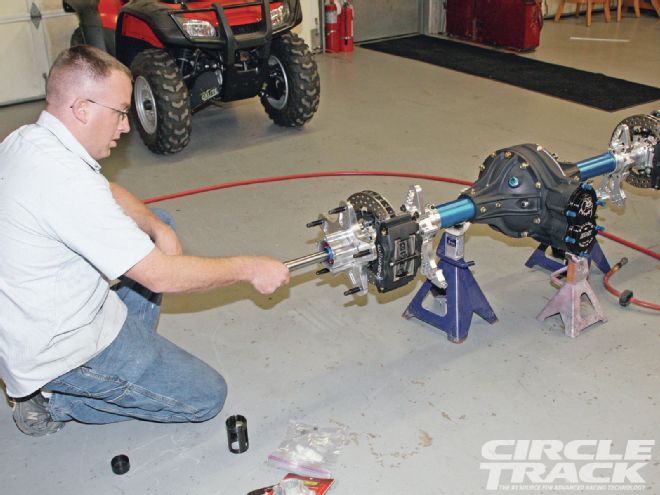
Quick-change rearends are an incredibly useful tool for racers. Instead of going through the laborious task of tearing down the center section to change out the ring-and-pinion every time you need to make a gear change, a quick-change rear allows the same result by simply removing the rear cover and swapping out a smaller set of gears which only requires a few minutes.
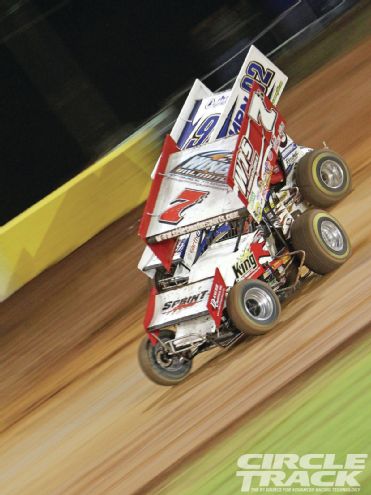 Bulldog Rear Ends made its name building high-strength, highly efficient quick-change rearends for 600-plus-horsepower Sprint Car racers, but recently began building a closed-tube quick-change for stock car racing as well.
Bulldog Rear Ends made its name building high-strength, highly efficient quick-change rearends for 600-plus-horsepower Sprint Car racers, but recently began building a closed-tube quick-change for stock car racing as well.
But in order to do this a quick-change rear must have a few extra components. This doesn't make the rearend any harder to operate, but it does require a few considerations to make sure everything is operating smoothly. For more information, we went to Keith Brightbill, Bulldog Rear Ends' resident expert for closed-tube rearends. Bulldog has long been a leading manufacturer of live axle quick-change rearends for Sprint Car racing, and now Bulldog has recently released it's very successful CT-1 closed tube rearend for stock car racing. We hit Brightbill with some of the questions racers most often have when first dealing with quick-change technology and here are the answers he gave us.
There are a variety of different quick-change gears I can purchase from my local speed shop or racing catalogs. How do I determine which ones are the best quality?
The best way to determine the quality when searching for a set of quick-change gears is basically by the material used. I don't ever recommend anybody run the 8620 steel in their gears. It's the cheapest steel out there used for quick-change gears. Everybody makes them, but for anybody racing with 500 horsepower or more I definitely don't recommend using them. Gears made with 8620 steel are just going to lead to long-term headaches.
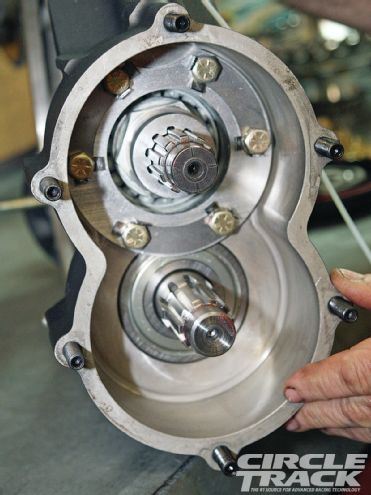 The beauty of a quick-change is swapping in the quick-change gears is quick and easy. Just pull the rear cover and slide the new gears in place.
The beauty of a quick-change is swapping in the quick-change gears is quick and easy. Just pull the rear cover and slide the new gears in place.
Instead of the cheaper 8620 gears, I definitely recommend spending a little bit more for the 9310 grade steel. You can basically tell what you are getting by the price. It's just like everything else in this world; you get what you pay for. For the quality stuff, you're probably never going to see it below $130 racer cost. On the other hand, the lower quality 8620 stuff is going to be anywhere between $60 and $75.
I just had a customer about six weeks ago who had to send his rearend back for some pretty serious repairs because he tried to save a buck by buying gears made from the cheaper steel. He blew out a set of quick-change gears, and he wound up wiping out everything. When the quick-change gears tore up, that metal went everywhere and basically ruined everything inside the case. In fact, it even cracked the gear cover side of the center section, so for the 60 bucks he saved buying the cheaper 8620 gears he basically ended up spending $1,200 to get his rearend fixed.
But don't I have to buy a bunch of quick-change gearsets to cover every possibility? Won't that cost add up?
If you're smart, you really don't need to own every quick-change gear in the catalog. This is especially true for guys that aren't travelling. If you're racing at the same track every week, conditions may change if you are racing on dirt, but even then, the size of the track never changes. I really don't know of many guys in that situation that are doing a lot of gear swaps. And it seems the guys that do change gears a lot are the guys that are trying to compensate for a bad setup. You should probably need only two or three gears at the most for any given track. So, when you look at it that way, it is really not hard to justify the expense for the better quality gears.
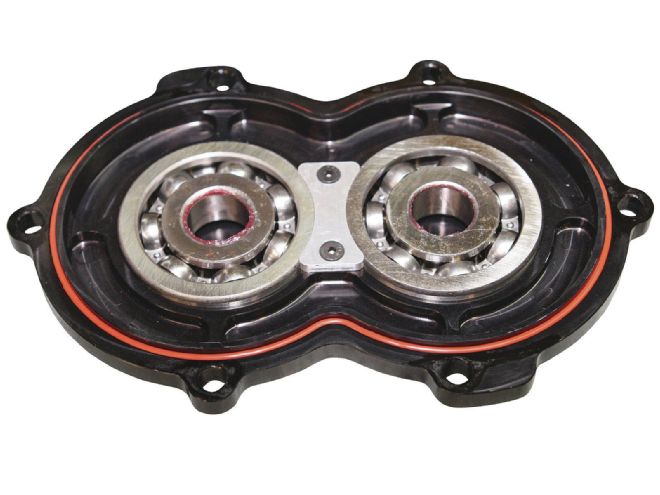 Lots of weekly racers use quick-changes and rarely change the gear ratio because they race the same track every week. But you should still pull the cover for a visual inspection after every race or two. Keep an eye not only on the gears, but also the internal bolts and the bearings in the cover.
Lots of weekly racers use quick-changes and rarely change the gear ratio because they race the same track every week. But you should still pull the cover for a visual inspection after every race or two. Keep an eye not only on the gears, but also the internal bolts and the bearings in the cover.
Any tips for avoiding mechanical troubles?
Really, the only secret is a good visual inspection. Even if you don't change your gears, you need to inspect them every week. If you leave the gear cavity closed and never open it up, then you not only aren't checking your quick-change gears, but you are also missing internal bolts and the bearings in the gear cover, as well as a lot of other components in the rearend you need to keep an eye on. Opening up the gear cover for a quick visual inspection also allows you to check the condition of your gear oil.
What are you looking for with a visual inspection?
Mostly cracks which could lead to broken gear teeth, but also signs of excessive heat, chips, and wear patterns. The lower quality gears are going to have machining marks in them right out of the box. And with those lower-quality gears you will see stress cracks show up almost immediately because the machining marks left behind create areas for the stress cracks to originate.
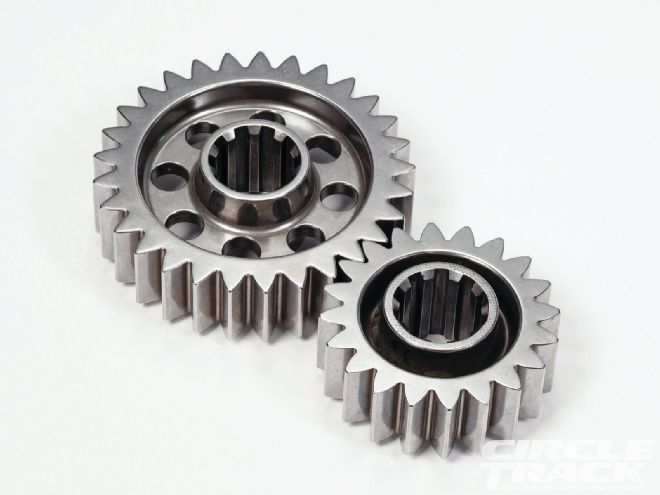 Make sure to look for quick-change gears made from high-grade 9310 steel. The higher quality steel also makes aggressive lightening programs possible.
Make sure to look for quick-change gears made from high-grade 9310 steel. The higher quality steel also makes aggressive lightening programs possible.
With higher-quality gears, you have steps taken during the manufacturing process to prevent the stress cracks from showing up. For example, we offer an extremely high-end quick-change gear. The majority of your gears are hobbed to create the gear teeth, and that's all that done. (Ed. note: Hobbing is a machining process which uses special type of milling machine that progressively slices into the piece being milled in a series of cuts. Compared to other gear forming processes it is relatively inexpensive.) But our gears are stone ground as an additional process, and that smoothes out the surface of the gear teeth. The process creates a perfect tooth mesh overlay for very efficient, trouble-free operation. You would think that the very high-end gears like this would be exclusively for the big money touring teams, but a lot of my crate guys are using them because they exhibit less friction and that, in turn, also heats the oil less. The result is these gears transfer more horsepower to the rear tires and you also get an improved gear lifespan.
Speaking of, if you aren't tearing up gears with abuse or a wreck on the racetrack, what is the useful lifespan of a set of quick-change gears?
Even if you're buying a quality set of gears—and especially if you're racing the same track weekly so you have the same set of gears in the rearend all the time—I would definitely recommend cycling them out at the end of the season. I understand that everybody is working under a budget and you hate spending money that you don't have to, but if you want to eliminate the chances of a catastrophic failure you need to cycle those gears out before they have a chance to fail on you. After all, the cost of a new set of gears is a lot less than the cost of making repairs to your rearend if hang onto a set of gears too long and they go out during a race. That may sound a bit extravagant, but even a set of high-quality gears is less than the cost of a right rear tire.
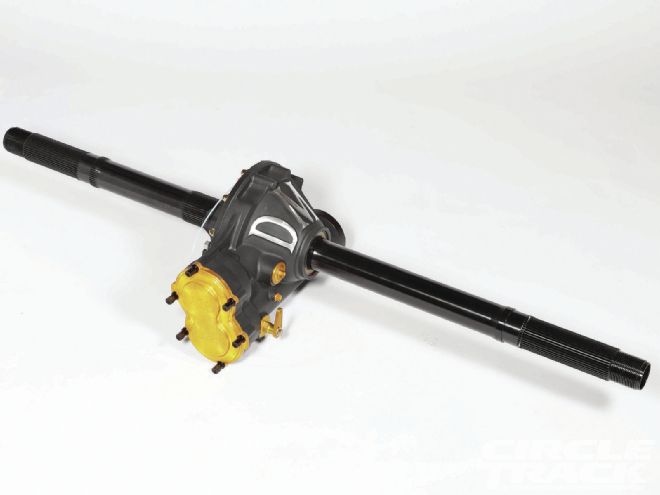 One of Bulldog’s super lightweight live axle quick-changes for Sprint Car racing.
One of Bulldog’s super lightweight live axle quick-changes for Sprint Car racing.
I'm mainly speaking about the racers running 410 Sprint Cars or Unlimited Late Models where they are pushing 600 horsepower or more. If you are running crates, you can probably get by with changing out your quick-change gears less often. You can always give us a call with your specific setup and track and we'll try to give you a safe estimation of how long you can go before needing to cycle out your gears.
Is there a gear oil that works best?
We have an oil made specifically for our equipment, which is a 70-90 weight fully synthetic gear oil that we developed specifically to our requirements. We spent two years field testing it in what we consider the most severe conditions in the country—which is 410 Sprint racing in Central Pennsylvania—and came up with a formula that we feel is superior to the rest. We worked with an oil manufacturer to help us develop the product and they did a lot of dyno testing independent of our own tests that backed up our findings.
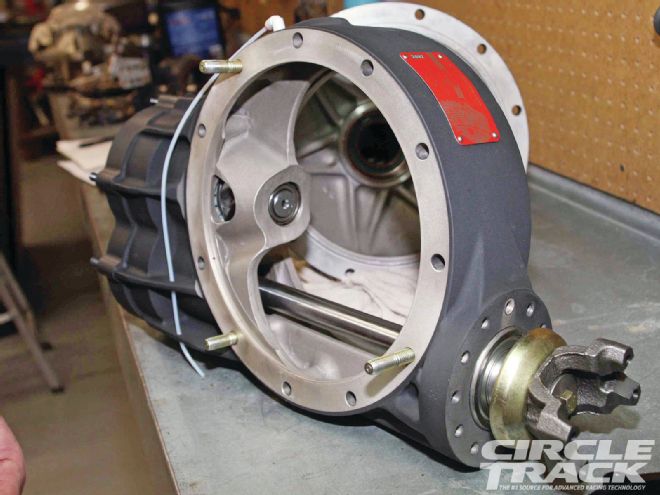 A quick-change uses a jackshaft that runs through the bottom of the bell to spin the quick-change gears in the back of the rearend.
A quick-change uses a jackshaft that runs through the bottom of the bell to spin the quick-change gears in the back of the rearend.
When it comes to what's most important for a racing gear oil, the answer is “everything.” It has to provide excellent lubrication, it has to have a wide heat range, and it has to resist breaking down. If it can't do everything well, it isn't going to be able to do the job on the racetrack. That's why we went to the trouble to develop our own gear oil specifically for our quick-change rearends.
How often should the gear oil be changed?
After break-in you should fully change the oil. With the high-horsepower stuff like the 410 Sprint Cars or Super Late Models, they are fully broken in after one race. Obviously, after break-in we recommend a complete dump and flush. After that, we usually recommend replacing your gear oil at 150- to 200-lap intervals. And that averages about every four races.
Speaking of break-in, what is the proper break-in process?
These pieces really don't require any break in. Just bolt it up, fill it with high-quality gear oil and hit the track. Bottom line, that's not going to hurt it. And it has to be that way because if the big 410 Sprint touring guys wreck and tear up a rearend during the middle of the year, they are going to put a new one in and go racing. There's no time to spend a bunch of effort breaking in a new rearend. If you want to, you can jack the rearend of the car up and run the car at 2,000 rpm for 20 minutes as a break in, but in terms of the quality of performance and longevity, what we've seen is our rearends, at least, don't require any dedicated break-in process.
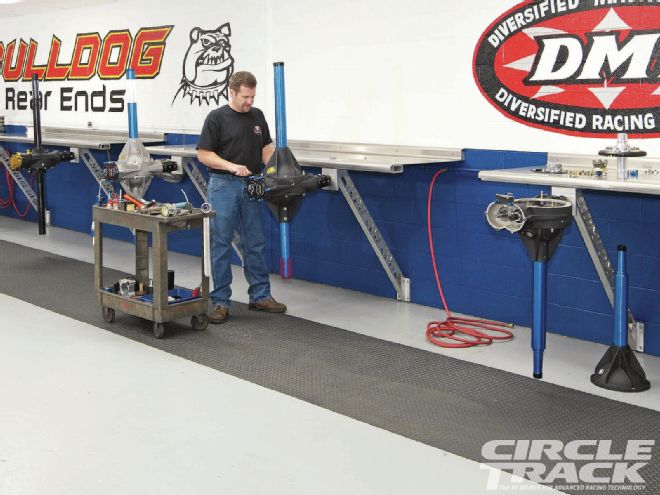 Bulldog techs building new quick-changes.
Bulldog techs building new quick-changes.
What range of gears should I bring to the track?
Like I said before, I really don't think you need to buy every gear in the catalog if you are smart about your gear choices. I have a hard time thinking anybody can tell a difference in five points of gear change. I've been racing a long time myself, and I know I can't tell from the driver seat. As an example, one inch of tire size change equals about five points of gear change. Now, if you are making a tire-size change and a gear change together in order to get 15 points of change, I can understand that. But if you are going to open up the quick-change cover to make five points of gear change, I think that's a bit of a waste of time and you probably will be better off working on your suspension.
In general, a 12- to 15-point jump is where a driver is going to be able to feel something on the racetrack. So I recommend, if you know generally how you want to be geared, you can carry three gears with you to the track for a 30-point sweep. But again, a lot of it has to do with your setup. If your car is right, you really don't have to change your gear too often. Honestly, a lot of times I'll see guys swapping gears when the real problem is the chassis setup or the wiring between the driver's head and his foot.
But to get back to it, having the right selection of gears in a 10- to 12-point sweep is a lot more important than buying and carrying around a bunch of gears that are too close together in ratio.
How useful are lightened and polished gears?
They do definitely work in terms of allowing more of the power your engine makes get to the rear wheels. Anything you can do to cut rotating weight or friction without making the gears too fragile is helpful. Our premium quick-change gears are both lightened and polished, and the premiere sets we offer have been lightened and polished, but they have also been cut to a narrower width.
For example, your basic standard quick-change gears weigh 6.25 pounds on average. But when you go to our lightened premium gear you are talking 4.5 pounds on average. That's a big savings right there; you're talking about 1.75 pounds of rotating weight. With our top-of-the-line gears we are able to get them down to 3.75 pounds by reducing the gear width. At the teeth, the gear is only 1 inch wide, but the spline area is actually still a standard width so the racer doesn't have to run a spacer or have to worry about forgetting the spacer and screwing up their equipment. And we didn't make a gear that's fragile, either. Those premium 1-inch-wide gears can handle full-power race cars no problem. They are actually rated for up to 1,000 horsepower.
What about lightening the ring-and-pinion?
That can also be very helpful. But you have to be careful, because lightening any gear really requires using high-grade steel. And a good lightening program can be really helpful for the guys that are racing on limited horsepower because it will help you get power to the ground more efficiently.
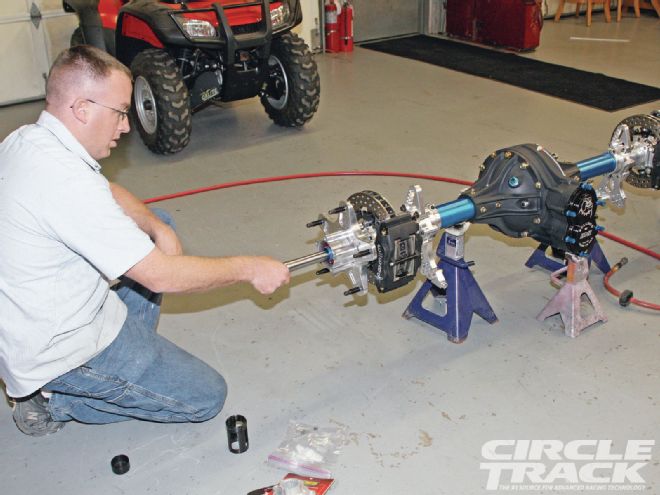 Track time is precious, and racers rarely have time to spare for an intricate break-in process. But with a quality rearend you can bolt it up to the car and go racing with no negative effects. Just make sure to completely flush and replace the gear oil after the first race.
Track time is precious, and racers rarely have time to spare for an intricate break-in process. But with a quality rearend you can bolt it up to the car and go racing with no negative effects. Just make sure to completely flush and replace the gear oil after the first race.
We have a lightening package that we do on our crate stuff, or really anything that will be under 500 horsepower. We can take around 2.5 pounds off the ring gear and it can still handle that power level reliably. Some of our competition in this market has tried to push a smaller ring-and-pinion, and we can get down to that same weight with a standard size gear. The advantage of that is if you move up to a higher horsepower class, all you need to purchase is a new ring-and-pinion. Everything else still works. But if you use the rearend featuring the smaller ring gear you will have to purchase an all new rearend. So, intelligently lightening your ring gears has a lot of advantages because you can match the lightening program to your application.
Do super lightweight gears like that require any extra precautions?
Yes. The more you lighten your gears, the more inspection you will need to do. Scalloping a gear promotes more flex and more movement. That means the gears themselves need to be watched for signs of wear, but you also need to check your ring gear bolts because flex can also cause bolts to work loose. So, with lightened ring gears you definitely need to inspect your ring gear bolts every handful of races.